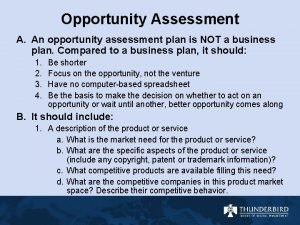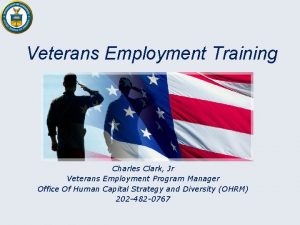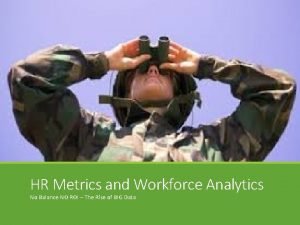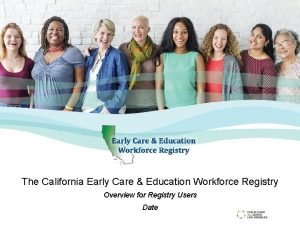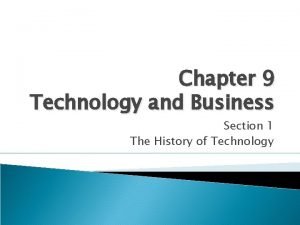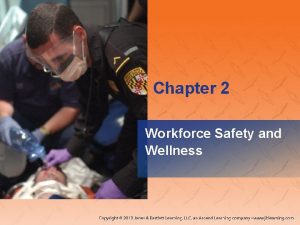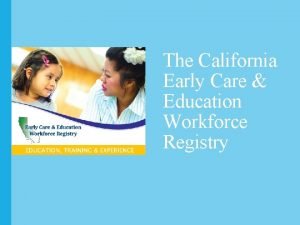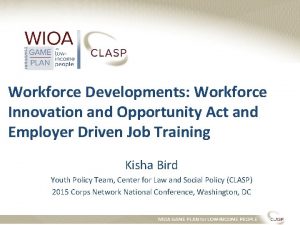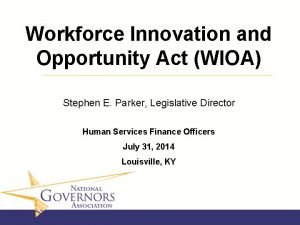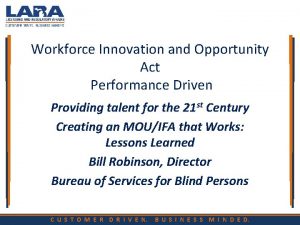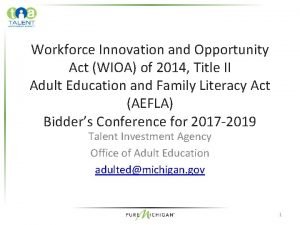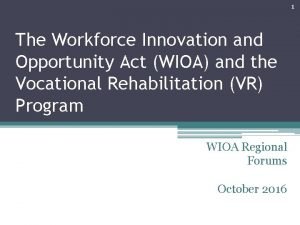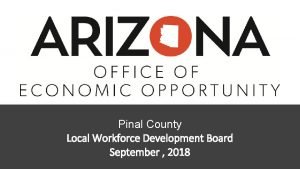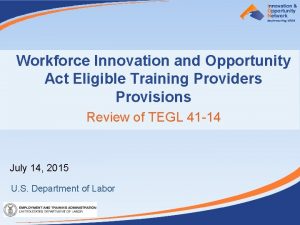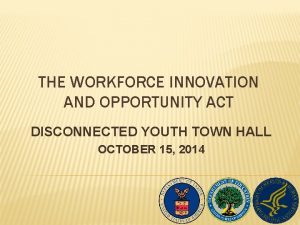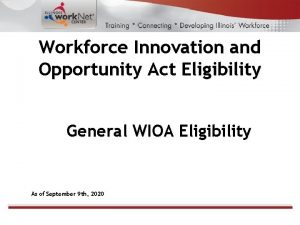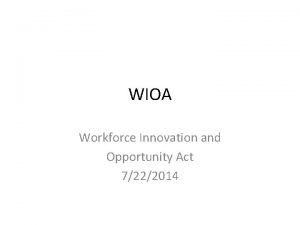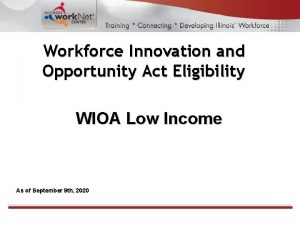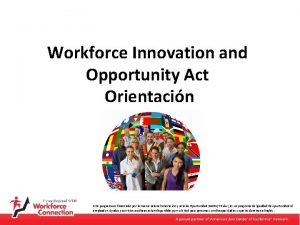The Workforce Innovation and Opportunity Act Important Changes



















- Slides: 19

The Workforce Innovation and Opportunity Act Important Changes to the Core Programs Presented by: Chaz Compton, Ed. D. , CRC The Workforce Innovation Technical Assistance Center WINTAC (www. wintac. org)

A Few Quick Facts • Signed into law July 22, 2014 • The full Act took effect on July 1, 2015, with a few exceptions like VR • First legislative reform in 16 years of the workforce system • A bipartisan effort • Still awaiting final regulations – maybe April

Core Partners • • DOL Programs Include: the Adult Program (title I), the Dislocated Worker Program (title I), the Youth Program (title I), the Wagner-Peyser Act Program (title III), Department of Education Programs Include: the Adult Education and Literacy Program (title II), and the Vocational Rehabilitation Program (title IV of WIOA and title I of the Rehabilitation Act of 1973).

Other Workforce Development Partners • Perkins career and technical education • UI - Unemployment Insurance • TANF – Temporary Assistance for • SCSEP - Senior Community Service • SNAP – Employment and training • HUD - Employment and training • TAA – Trade adjustment assistance for • CSBG - Community Services Block • JVSG - Jobs for Veterans State Grants • Re. Xo - Reintegration of Ex-Offenders programs Needs Families Program programs under the Supplemental Nutrition Assistance Program workers program Programs Employment Program activities carried out by the Department of Housing and Urban Development Grant Program

How did we get to WIOA? • The recession of 2007 • The changing and evolving workplace – what that meant for training • • and jobs Major skills gap identified Employment and training programs working in silos, even with WIA Identified need for starting early and creating career pathways Financial bailout, ARRA, the automakers and the need to change our usual way of doing business

Important Elements of WIOA • Strategic alignment of workforce development programs • Requires unified planning • Requires the adoption of common performance measures for all core programs • Focuses on improving services to employers and job-driven training • Improves the American Job Center System • Improves services to youth, individuals with disabilities and other vulnerable populations

Important Changes to the Rehab Act in WIOA • Requires pre-employment transition services and a 15% reserve or set • • • aside for the provision of PETS Requires 50% of the Supported Employment funds be spent on youth Requires VR programs to engage with employers Promotes competitive integrated employment (Section 511) Promotes customized employment for individuals with the most significant disabilities Reduces the minimum level of education needed for qualified rehabilitation professionals Moves IL to the Department of Health and Human Services

More Changes to VR • IPE must be written within 90 days • Extended services in SE can go up to 4 years by the VR program if it is for youth • Support advance training in STEM fields • Eligibility for individuals whose disability prevents them from advancing in employment • No longer use the Standards and Indicators but the common performance measures

Integration and Alignment of Programs • What does the law mean when it says that the core program should be integrated and strategically aligned? • Goes well beyond cross-referral • Consider VR for a moment. How would you define integration for the VR program? How would you know it is integrated? • Groups: Identify at least three current challenges to full integration of the core programs in CNMI. • Identify at least three specific actions that will demonstrate integration of the partners. What will you specifically do differently as a result of the new law?

RSA’s Definition of Integration • How is RSA defining whether the VR program is integrated into the workforce development system? • An increase in the number of individuals with disabilities that obtain competitive employment as a result of the partnership with Workforce Development core partners. • • How is that determined? Shared cases 2 nd way – increased and improved collaboration with core partners How is that determined?

An Example of Integrated Service • 23 year old with ADHD dropped out of high school prior to graduation and no GED • • • Obtains GED Enters the nursing program with shared funding from OVR and workforce Support services provided by both OVR and workforce Internship/work experience arranged through any of the agencies Job referral and placement provided in concert with Wagner-Peyser funded program • Tracking of progress and shared information by all entities

Job-Driven Training • Report to the President from VP Joe Biden. When was it released? • America’s workforce system must focus its resources on preparing individuals to acquire the skills that are in demand by employers. • Demand-side in addition to supply-side • Major focus on work experience, apprenticeships, internships, OJTs, and any other kind of work experience • Customized Training • All funded programs working together to prepare individuals to meet employer needs (Strategically aligned)

What Works to Achieve the Vision • • • Engaging employers – Not just in hiring, but in training Earn and learn – work experiences, internships, apprenticeships Use of data to drive choices and decisions Measurement of success of programs – program evaluation Career Pathways Breaking down barriers for people who have needs like child care, transportation, other support services, as well as people with disabilities

Accountability • Common Performance Accountability Measures for Adults: • % in unsubsidized employment during the second quarter after exit from the • • program; % in unsubsidized employment during the fourth quarter after exit from the program; Median earnings of those in unsubsidized employment during the second quarter after exit from the program; % of participants who obtained a recognized postsecondary credential or secondary school diploma or equivalent during participation in, or within one year of, exit from the program; % of participants, who during a program year, are in an education or training program that leads to a recognized postsecondary credential or employment and who are achieving measurable skill gains toward such a credential or employment; and

Accountability Measures for Youth • The percentage of program participants who are in education or training activities, or in unsubsidized employment, during the second quarter after exit from the program; • The percentage of program participants who are in education or training activities, or in unsubsidized employment, during the fourth quarter after exit from the program; • Median earnings of those in unsubsidized employment during the second quarter after exit from the program; • % of participants who obtained a recognized postsecondary credential or secondary school diploma or equivalent during participation in, or within one year of, exit from the program; • % of participants, who during a program year, are in an education or training program that leads to a recognized postsecondary credential or employment and who are achieving measurable skill gains toward such a credential or

Accountability Continued • Performance levels established for all core programs • Negotiated with DOL and DOE for the first two years and set during the 3 rd and 4 th year based on several factors identified in the law • What is the most common way to begin to set performance standards that you haven’t had before? • Do you gather this information now? If not, it is time to begin. • Let’s review the outcome measures again and see what you data you would have to gather and report on

Accountability with Teeth • You don’t hit your performance standards for any one program year – what happens? • TA and a performance improvement plan (PIP) • 2 nd year in a row – what happens? • 5% reduction in State allocation of funding withheld until performance is met • 3 rd year in a row? • Reorganization of Board, prohibit use of underperforming providers, and other actions deemed necessary

CNMI and WIOA • • • Who will define for you what CNMI should be doing under WIOA? Who will identify what job-driven training means here? The opportunities and challenges of size Partnerships with employers are going to be a key Secondary education is a crucial partner, even though they are not identified as a core partner • Each program has to go beyond their traditional walls while retaining their identity

Questions?
 An opportunity assessment plan:
An opportunity assessment plan: Training implementation plan example
Training implementation plan example Workforce innovation fund
Workforce innovation fund Besigheidsplan
Besigheidsplan Radical innovation vs disruptive innovation
Radical innovation vs disruptive innovation Elizabeth mulroney
Elizabeth mulroney Chemical change definition
Chemical change definition Macbeth act 3-5 summary
Macbeth act 3-5 summary Housing opportunity through modernization act of 2016
Housing opportunity through modernization act of 2016 5 cfr 213,3102(u)
5 cfr 213,3102(u) Newspaper article format
Newspaper article format Inverted pyramid in news writing
Inverted pyramid in news writing Least important to most important
Least important to most important Important things that happened in act 4 of romeo and juliet
Important things that happened in act 4 of romeo and juliet Romeo and juliet quotes from act 3
Romeo and juliet quotes from act 3 Hr metrics and workforce analytics
Hr metrics and workforce analytics Early care and education workforce registry
Early care and education workforce registry The most common technology staple in business today is the
The most common technology staple in business today is the Chapter 2 workforce safety and wellness
Chapter 2 workforce safety and wellness California workforce registry
California workforce registry
